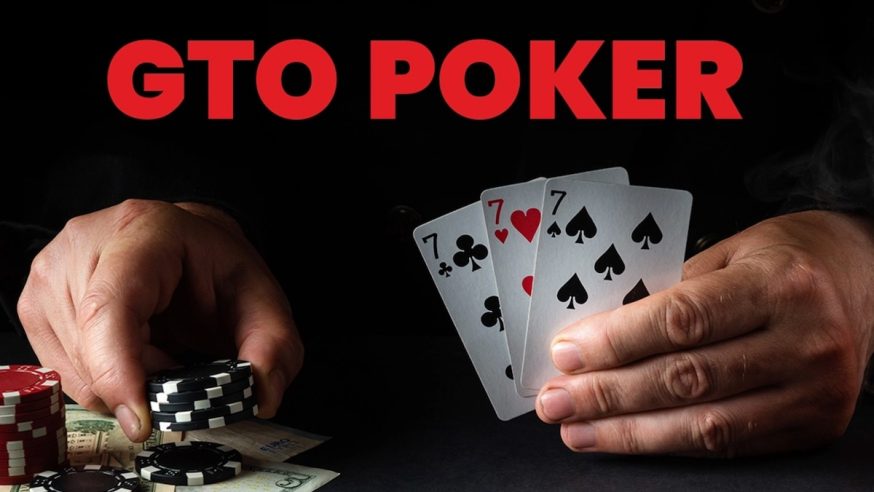When you’ve won six WSOP bracelets, countless millions and are the reigning PokerGO Tour Championship winner, what else is there…
Read MoreThe modern game of poker exists within an era of ‘GTO’ Game Theory Optimisation, or Game Theory Optimal play is a form of strategy but more than that, it is often heralded more of a way of poker life, of shaping your traits and trends to an elite mindset of theory that once put into practice can only put you on the path to success.
From poker players who get ‘optimal’ rest and exercise to others who plan for their time at the felt with GTO actions in study time, playing ‘GTO Poker’ is changing the face of the world’s favorite card game, from players in $1/$2 cash games to the poker elite playing super high roller events that cost six figures to enter.
What is GTO strategy and how has its evolution changed the game? Let’s find out.
What Does GTO Mean?
Game Theory Optimal (GTO) poker has come from the rise of machines, in poker’s case solvers, which effectively are massive databases able to help work out the optimal play in any poker situation. This GTO theory is then put into practice by the best players in thw world and it drips down into common strategy.
While in the past poker players acted on feel and instinct, these days, making themselves ‘unexploitable’ is at the heart of the poker elite’s mindset. GTO strategy is a Nash equilibrium – mixed strategies that in theory are unable to be exploited over the long-term, thus form a constant strategy that is logic-bound to bring results eventually.
Of course, in the short term of any single poker hand, they can lose, but so can any strategy and the theory is that GTO play will always win eventually… because the math behind it says so.
That’s the beauty of GTO – you’re not battling an individual opponent but rather the game itself. In theory, this should make bad beats easier to stomach… but in practice, this isn’t always the case. GTO is a balanced strategy that prevents your opponents from profiting by exploiting your tendencies. You have no tendencies, you have GTO, the idealogy suggests; you change your stack sizing, positions and other factors based on board texture and opponent’s tendencies Of course, if everyone is playing GTO, then the unexploitable becomes a pattern that itself is easy to read. But we’re not there yet.
From Balance to Beating the Game
Poker is a lot like life in the sense that balance is everything. Before GTO play, balancing your ranges, your actions, your bluffs, calls and raises was everything, too. The solver era has changed all that. Software can now approximate equilibrium strategies for complex trees using counterfactual regret minimization. Sounds scientific, but it’s actually logic based. Servers run situations for hours based on a huge amount of information and then put forward a logical action for players at each point of the hand. Sites such as GGPoker utilize GG WWizard to help players during gameplay to suggest the correct action to make.
In fact, in recent GGMillion$ games on Tuesday evenings, players in the $10,300-entry online event have seen their actions played out on the site’s YouTube channel with the GGWizard advice displayed on screen at the same time. It’s a fascinating development in screening poker online as it actively helps fans and players watching to become better at at poker but in a specific style.
In many senses, Artificial Intelligence – or AI – is an essential in human life that will one day become simply part of the fabric of the world, an overlayed skin unnoticeable by the naked eye but a sheen over every facet of our lives, from the home to your work and of course, our hobbies. Poker is simply one of the first facets of life to be adaptable to AI, replacing the balance of deliberate actions by human beings and replacing it with the more dominant and reliable balancing of ranges as dictated by GTO solvers.
Play the Pattern Not the Printout
In GTO theory, exploiting not specific hands but patterns that you see is pivotal to its success. The more you study GTO – and of course, poker in general – the more that you discover patterns are everywhere and can therefore be exploited. This can mean changing your strategy from what it was before, of course.
Where you might look at a mixed texture before with some trepidation if you hit middle pair, GTO play can alter your perception of the game to think more exploitatively, polarizing your bets more. For instance, you might be tempted to bet for thin value but adapt to either checking or betting larger in the future.
If you have a range advantage, betting smaller is more favorable in the advent of GTO. So too are larger, more polarized bets on boards that change rapidly, as you seek to exploit weaker more range-set opponents who are less adaptable to change in their minds when compared to a solver that can adapt in a simple but rapier-sharp leap of logic. It takes us longer to work out where to change, but by learning the solver play, we’re at an advantage, because it saves brainpower for spotting physical tells, for example.
Blockers and Beyond
GTO bluffing prefers hands that block your opponent’s strongest continuing ranges are extremely powerful and in GTO strategy, are highly respected. For example, if a flush has come in on the river of a board without a pair (three community cards arriving in the same suit) then you can make what’s known as an exploitative bluff by bluffing with the ace of the flush suit. You have the ace of spades so you know therefore that your opponent cannot have the nut flush. The pressure is then on them to make the call with what you know cannot be the nuts.
Another good example of GTO strategy helping you win hands you have no right to take down could come on a dry run-out. Let’s foresee that you arrive at the river with a polarized range (a great hand or no hand at all) and pot-size your bluff bet on the river. Your bluff-to-win ratio with the hand in question needs to be 1:1 to succeed, i.e. 50% of the time you get a fold, to break even. Keeping your range to have equal bluffs and made winning hands forces your opponent to try to out-strategize an unexploitable number. What they aim to do simply cannot be done, and more often than not – improving on 1:1 – you’ll get a lay-down and profit.
Position Prints Money
In poker, as the oldest and newest strategies of the game tell you, position is everything. Betting in late position can buy you money over time and using pre-flop charts, you can get used to optimal thinking and establish a basis for playing GTO poker. While full equilibrium preflop solutions depend on rake and stack depth, a few patterns emerge from studying those charts:
- Open wide on the button, play your tightest when UTG
- Three-bet when polarized out of position, merge in position
- Play a polarized strategy from the blinds
- Rather than call from the small-blind, add in aggressive three-bets
- Don’t under-defend river bets, but check or raise instead to polarize your actions and confuse your opponents
- Range c-bet on ace-high or king-high dry flops
- On coordinated turn cards, slow down more when out of position
- Check more middling hands and polarize your larger bets when you are aggressive
- Pick bluffs that have blockers to your opponent’s calling range
A Typical GTO Strategy Hand
Let’s walkthrough a typical hand using GTO as a basis for our actions.
You open from the button with A♦5♦. The Big Blind player calls. A flop of K♣7♠2♥ gives you range advantage and the board is dry. GTO strategy favors frequent small bets here, so you bet 33% with much of your range including A♦5♦ as a backdoor bluff. The Big Blind calls.
On the turn, the 4♣ lands. That’s a great card for you because it adds a wheel draw and slightly favors your range. GTO players continue often here with small-to-medium sizing, mixing in some checks so you bet 66% – gaining fold equity and setting up leverage for the river. The Big Blind player calls again.
On the river of a K♦, completing the board as K♣7♠2♥4♣K♦, the Big Blind player checks again. Your value is polarized. You could have ace-king, a few sets, and strong king-high hands that have rivered trips. Of course, your bluffs include hands exactly like the one you’re holding, some backdoor whiffs and wheels draws that failed to stick the landing.
If you choose a pot bet, then you need to build an approximate 1:1 bluff-to-value ratio using the best blockers. Your hand – A♦5♦ – blocks a quarter of A-K call-downs with your ace and unblocks hands that have the seven in them. It’s totally fine to bluff with ace-five here and you do so, exploiting your opponent and getting a satisfying fold.
In Conclusion
There are limits to playing pure GTO strategy poker. Eventually, the moves will be so common that exploiting GTO ranges and plays will be the new trend. Anti-Ai, if you will, and if you aren’t already anticipating that then we can only presume you’re aiming to stop playing poker at some stage.
Human error is an interesting phenomenon. It is, of course, highly common when compared to computer error. But it also features instincts that rely on a computer system older than any computers out there – our brains. Over thousands of years, we have fine-tuned them to anticipate danger, shield us from risk and anticipate trouble. We can exploit, divert, use cunning and strategize against other theories faster than computers in the moment. After all, when running a complex hand into a solver, it might take 8-10 hours to produce a definitive result. Even Will Kassouf doesn’t take that long deciding whether he’s going to fold or call a river bet.
The perfect GTO strategy is a strictly aspirational term. But by studying GTO and analysing current optimal plays, we can stay ahead of the curve and be best prepared to pivot when the tipping point comes and we revert to playing against perceived GTO methods. A decade ago, saying ‘I ran an interesting node’ to a friend in poker might have drawn a confused reaction. Today, it often leads to a nod of recognition between two friends at the top of their game.
From solver screenshots to EV heatmaps, equilibrium-informed heuristics to pool reads, the age of GTO strategy isn’t just upon us, we’re living through it right now. GTO hasn’t killed the soul of poker, it’s sharpened its mind. Now the way to balance you poker play is to study equilibrium to become unexploitable and exploit deviations to become unbeatable.
If that doesn’t say GTO to you, we’ve got a solver we can recommend.

